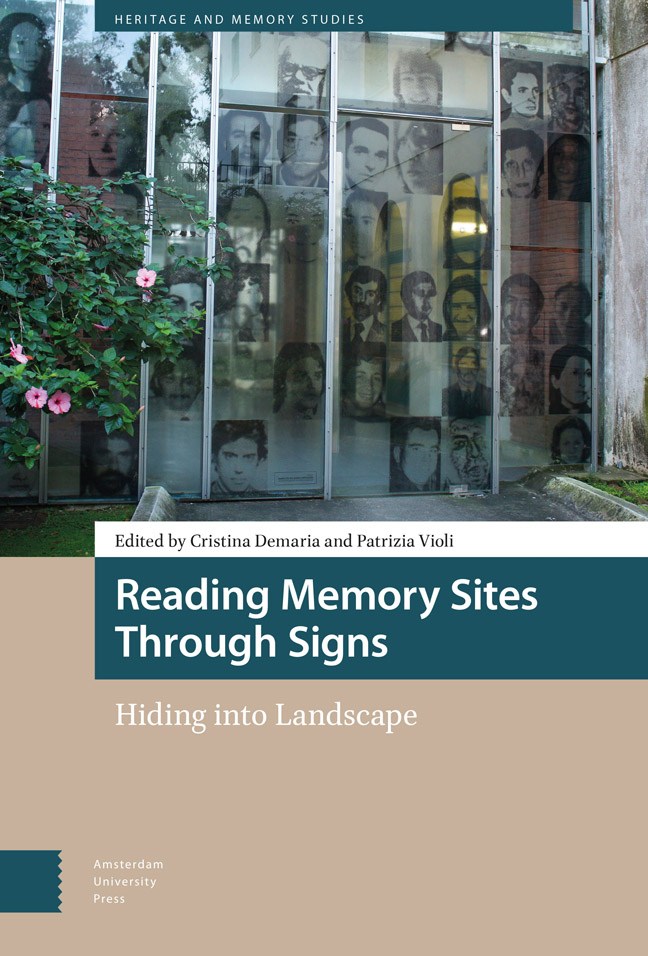Book contents
- Frontmatter
- Contents
- List of Illustrations
- For a Semiotics of Spaces of Memories: Practices of Enunciation and Narratives from Monuments to Global Landscapes of Inheritance
- 1 Stories that Shape Spatialities: Lieu and Milieu de Mémoire through the Lens of Narrativity
- 2 Interpretation and Use of Memory: How Practices Can Change the Meanings of Monuments
- 3 Uncomfortable Memories of Fascist Italy: The Case of Bigio of Brescia
- 4 What Does Fascist Architecture Still Have to Tell Us?: Preservation of Contested Heritage as a Strategy of Re-Enunciation and ‘Voice Remodulation’
- 5 Berlin, the Jewish Museum and the Holocaust Memorial
- 6 Making Space for Memory: Collective Enunciation in the Provincial Memory Archive of Córdoba, Argentina
- 7 Ruins of War: The Green Sea and the Mysterious Island
- 8 Turning Spaces of Memory into Memoryscapes: Cinema as Counter-Monument in Jonathan Perel's El Predio and Tabula Rasa
- 9 Voices from the Past: Memories in a Digital Space: The Case of AppRecuerdos in Santiago, Chile
- 10 500,000 Dirhams in Scandinavia, from Mobile Silver to Land Rent: A Semiotic Analysis
- Index
- Index of Names
For a Semiotics of Spaces of Memories: Practices of Enunciation and Narratives from Monuments to Global Landscapes of Inheritance
Published online by Cambridge University Press: 17 February 2024
- Frontmatter
- Contents
- List of Illustrations
- For a Semiotics of Spaces of Memories: Practices of Enunciation and Narratives from Monuments to Global Landscapes of Inheritance
- 1 Stories that Shape Spatialities: Lieu and Milieu de Mémoire through the Lens of Narrativity
- 2 Interpretation and Use of Memory: How Practices Can Change the Meanings of Monuments
- 3 Uncomfortable Memories of Fascist Italy: The Case of Bigio of Brescia
- 4 What Does Fascist Architecture Still Have to Tell Us?: Preservation of Contested Heritage as a Strategy of Re-Enunciation and ‘Voice Remodulation’
- 5 Berlin, the Jewish Museum and the Holocaust Memorial
- 6 Making Space for Memory: Collective Enunciation in the Provincial Memory Archive of Córdoba, Argentina
- 7 Ruins of War: The Green Sea and the Mysterious Island
- 8 Turning Spaces of Memory into Memoryscapes: Cinema as Counter-Monument in Jonathan Perel's El Predio and Tabula Rasa
- 9 Voices from the Past: Memories in a Digital Space: The Case of AppRecuerdos in Santiago, Chile
- 10 500,000 Dirhams in Scandinavia, from Mobile Silver to Land Rent: A Semiotic Analysis
- Index
- Index of Names
Summary
Abstract
This chapter offers an introduction to the semiotic approach to the space of memory. After defining in what terms space is a language, we focus on two key concepts: narrativity and enunciation. The former, which should not be equated with a story or plot, is understood as the fundamental organisation of meaning, the form that structures our experiences. The latter concerns not the physical production of a text but the traces left by the enunciator in the text, and, more specifically, it may be represented by the architectural style of a building, the form of an urban plan or the display in a museum. In the second part, we present the theoretical and methodological specificities of the contributions in this volume.
Keywords: Semiotics of Space; Semiotic Methodology; Cultural Memory; Narrativity; Enunciation.
This Book
This book aims to present the most relevant concepts of semiotic methodology to a wide audience of scholars and researchers working on memory who may not be familiar with a semiotic approach. In order to do so, we have decided to focus on space, analysing different kinds of spaces, real and virtual, from cities to monuments, from architecture to urban practices, from museums to spaces represented in documentary films or imagined through digital devices. Such a choice implies two main questions: why space? And why semiotics?
As we will briefly explain in this introduction, from a semiotic perspective space is in itself a language, or, to use Jurij Lotman's words (1992), a modelling system, capable of giving shape to the world and at the same time of being modelled by it. Space talks about our values and the structure of our society, but also, and maybe in the first place, about what we have been, about our past and the transformations it has undergone. Space therefore represents a highly privileged vantage point for the understanding of our memory of the past, as well as – as we shall see throughout the chapters of this book – of the way in which space itself produces memory, rewriting, transforming, interpreting and sometimes erasing it. Space is indeed the storage of our collective memory, where we can find and read the traces of memorial processes: no study of cultural memory can neglect the spatial traces left by it.
Why can semiotics be important to scholars working on these topics within different frameworks and even different disciplines?
- Type
- Chapter
- Information
- Reading Memory Sites through SignsHiding into Landscape, pp. 11 - 30Publisher: Amsterdam University PressPrint publication year: 2023

